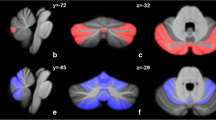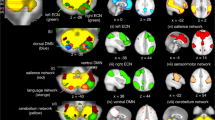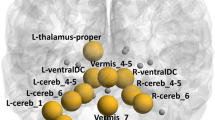Abstract
The cerebellum involves diverse functions from motor coordination to higher cognitive functions. Impairment of the cerebellum can cause ataxia and cerebellar cognitive affective syndrome. Multiple system atrophy of the cerebellar type (MSA-C) is a neurodegenerative disorder with atrophy of medullo-ponto-cerebellar (MPC) white matter (WM). To understand the role of the cerebellum from the perspective of the local structure to the global function in the presence of MPC WM degeneration, we acquired T1-weighted and diffusion tensor images for 17 patients with MSA-C and 19 normal controls. We concurrently used the measures of local morphology, including MPC WM volume and inner surface area, and properties of global network organization based on graph theory for the MSA-C and control groups. The results showed that MPC WM degeneration caused the destruction of cerebello-ponto-cerebral loops, resulting in reduced communication efficiency between regions in the whole-brain network. In addition, the sulcal area of the inner cortical surface in the cerebellum decreased linearly with the MPC WM volume, and the inferoposterior lobe exhibited a steeper atrophy rate than that of vermis regions. We concluded that the integrity of MPC WM is critical in sustaining the local morphology and the global functions of the whole-brain fiber network.








Similar content being viewed by others
References
Achard S, Bullmore E (2007) Efficiency and cost of economical brain functional networks. PLoS Comput Biol 3:e17
Armstrong RA, Cairns NJ, Lantos PL (2007) A quantitative study of the pathological changes in white matter in multiple system atrophy. Neuropathology 27:221–227
Beg MF, Miller MI, Trouvé A, Younes L (2005) Computing large deformation metric mappings via geodesic flows of diffeomorphisms. Int J Comput Vision 61:139–157
Brenneis C, Boesch SM, Egger KE, Seppi K, Scherfler C, Schocke M, Wenning GK, Poewe W (2006) Cortical atrophy in the cerebellar variant of multiple system atrophy: a voxel-based morphometry study. Mov Disord 21:159–165
Bullmore E, Sporns O (2009) Complex brain networks: graph theoretical analysis of structural and functional systems. Nat Rev Neurosci 10:186–198
Chen H, Zhang T, Guo L, Li K, Yu X, Li L, Hu X, Han J, Hu X, Liu T (2012) Coevolution of gyral folding and structural connection patterns in primate brains. Cereb Cortex. doi:10.1093/cercor/bhs113
Gilman S, Wenning GK, Low PA, Brooks DJ, Mathias CJ, Trojanowski JQ, Wood NW, Colosimo C, Dürr A, Fowler CJ, Kaufmann H, Klockgether T, Lees A, Poewe W, Quinn N, Revesz T, Robertson D, Sandroni P, Seppi K, Vidailhet M (2008) Second consensus statement on the diagnosis of multiple system atrophy. Neurology 71:670–676
Habas C, Kamdar N, Nguyen D, Prater K, Beckmann CF, Menon V, Greicius MD (2009) Distinct cerebellar contributions to intrinsic connectivity networks. J Neurosci 29:8586–8594
Habas PA, Scott JA, Roosta A, Rajagopalan V, Kim K, Rousseau F, Barkovich AJ, Glenn OA, Studholme C (2012) Early folding patterns and asymmetries of the normal human brain detected from in utero MRI. Cereb Cortex 22:13–25
Harris AD, Pereira RS, Mitchell JR, Hill MD, Sevick RJ, Frayne R (2004) A comparison of images generated from diffusion-weighted and diffusion-tensor imaging data in hyper-acute stroke. J Magn Reson Imaging 20:193–200
Hauser T-K, Luft A, Skalej M, Nägele T, Kircher TTJ, Leube DT, Schulz JB (2006) Visualization and quantification of disease progression in multiple system atrophy. Mov Disord 21:1674–1681
Hilgetag CC, Barbas H (2006) Role of mechanical factors in the morphology of the primate cerebral cortex. PLoS Comput Biol 2:e22
Holmes G (1939) The cerebellum of man. Brain 62:1–30
Hu H-H, Guo W-Y, Chen H-Y, Wang P-S, Hung C-I, Hsieh J-C, Wu Y-T (2009) Morphological regionalization using fetal magnetic resonance images of normal developing brains. Eur J Neurosci 29:1560–1567
Hu H-H, Chen H-Y, Hung C-I, Guo W-Y, Wu Y-T (2013) Shape and curvedness analysis of brain morphology using human fetal magnetic resonance images in utero. Brain Struct Funct. doi:10.1007/s00429-012-0469-3
Ito M, Watanabe H, Kawai Y, Atsuta N, Tanaka F, Naganawa S, Fukatsu H, Sobue G (2007) Usefulness of combined fractional anisotropy and apparent diffusion coefficient values for detection of involvement in multiple system atrophy. J Neurol Neurosurg Psychiatry 78:722–728
Jernigan TL, Archibald SL, Fennema-Notestine C, Gamst AC, Stout JC, Bonner J, Hesselink JR (2001) Effects of age on tissues and regions of the cerebrum and cerebellum. Neurobiol Aging 22:581–594
Kanazawa M, Shimohata T, Terajima K, Onodera O, Tanaka K, Tsuji S, Okamoto K, Nishizawa M (2004) Quantitative evaluation of brainstem involvement in multiple system atrophy by diffusion-weighted MR imaging. J Neurol 251:1121–1124
Kawai Y, Suenaga M, Takeda A, Ito M, Watanabe H, Tanaka F, Kato K, Fukatsu H, Naganawa S, Kato T, Ito K, Sobue G (2008) Cognitive impairments in multiple system atrophy. Neurology 70:1390–1396
Kelly RM, Strick PL (2003) Cerebellar loops with motor cortex and prefrontal cortex of a nonhuman primate. J Neurosci 23:8432–8444
Kochunov P, Mangin J-F, Coyle T, Lancaster J, Thompson P, Rivière D, Cointepas Y, Régis J, Schlosser A, Royall DR, Zilles K, Mazziotta J, Toga A, Fox PT (2005) Age-related morphology trends of cortical sulci. Hum Brain Mapp 26:210–220
Koenderink JJ, van Doorn AJ (1992) Surface shape and curvature scales. Image Vis Comput 10:557–564
Latora V, Marchiori M (2001) Efficient behavior of small-world networks. Phys Rev Lett 87:198701
Le Gros Clark W (1945) Deformation patterns in the cerebral cortex: essays on growth and form. Oxford University Press, London
Lee Y-C, Liao Y-C, Wang P-S, Lee IH, Lin K-P, Soong B-W (2011) Comparison of cerebellar ataxias: a three-year prospective longitudinal assessment. Mov Disord 26:2081–2087
Li K, Guo L, Li G, Nie J, Faraco C, Cui G, Zhao Q, Miller LS, Liu T (2010) Gyral folding pattern analysis via surface profiling. NeuroImage 52:1202–1214
Lindblad J (2005) Surface area estimation of digitized 3D objects using weighted local configurations. Image Vis Comput 23:111–122
Lu C-F, Soong B-W, Wu H-M, Teng S, Wang P-S, Wu Y-T (2013) Disrupted cerebellar connectivity reduces whole-brain network efficiency in multiple system atrophy. Mov Disord 28:362–369
Mori S, Crain BJ, Chacko VP, Van Zijl PCM (1999) Three-dimensional tracking of axonal projections in the brain by magnetic resonance imaging. Ann Neurol 45:265–269
Mori S, Wakana S, Nagae-Poetscher L, Zijl PV (2006) MRI atlas of human white matter. Elsevier, Amsterdam
Mota B, Herculano-Houzel S (2012) How the cortex gets its folds: an inside-out, connectivity-driven model for the scaling of mammalian cortical folding. Front Neuroanat. doi:10.3389/fnana.2012.00003
O’Reilly JX, Beckmann CF, Tomassini V, Ramnani N, Johansen-Berg H (2010) Distinct and overlapping functional zones in the cerebellum defined by resting state functional connectivity. Cereb Cortex 20:953–965
Papp MI, Kahn JE, Lantos PL (1989) Glial cytoplasmic inclusions in the CNS of patients with multiple system atrophy (striatonigral degeneration, olivopontocerebellar atrophy and Shy-Drager syndrome). J Neurol Sci 94:79–100
Quinn N (1989) Multiple system atrophy—the nature of the beast. J Neurol Neurosurg Psychiatry 52:78–89
Rajagopalan V, Scott J, Habas PA, Kim K, Corbett-Detig J, Rousseau F, Barkovich AJ, Glenn OA, Studholme C (2011) Local tissue growth patterns underlying normal fetal human brain gyrification quantified in utero. J Neurosci 31:2878–2887
Ramnani N (2006) The primate cortico-cerebellar system: anatomy and function. Nat Rev Neurosci 7:511–522
Ramnani N, Behrens TEJ, Johansen-Berg H, Richter MC, Pinsk MA, Andersson JLR, Rudebeck P, Ciccarelli O, Richter W, Thompson AJ, Gross CG, Robson MD, Kastner S, Matthews PM (2006) The evolution of prefrontal inputs to the cortico-pontine system: diffusion imaging evidence from macaque monkeys and humans. Cereb Cortex 16:811–818
Rubinov M, Sporns O (2010) Complex network measures of brain connectivity: uses and interpretations. NeuroImage 52:1059–1069
Schmahmann JD (1991) An emerging concept: the cerebellar contribution to higher function. Arch Neurol 48:1178–1187
Schmahmann JD (1996) From movement to thought: anatomic substrates of the cerebellar contribution to cognitive processing. Hum Brain Mapp 4:174–198
Schmahmann JD (2004) Disorders of the cerebellum: ataxia, dysmetria of thought, and the cerebellar cognitive affective syndrome. J Neuropsychiatry Clin Neurosci 16:367–378
Schmahmann JD, Pandya DN (1989) Anatomical investigation of projections to the basis pontis from posterior parietal association cortices in rhesus monkey. J Comp Neurol 289:53–73
Schmahmann JD, Sherman JC (1998) The cerebellar cognitive affective syndrome. Brain 121:561–579
Schmitz-Hübsch T et al (2006) Scale for the assessment and rating of ataxia. Neurology 66:1717–1720
Shiga K, Yamada K, Yoshikawa K, Mizuno T, Nishimura T, Nakagawa M (2005) Local tissue anisotropy decreases in cerebellopetal fibers and pyramidal tract in multiple system atrophy. J Neurol 252:589–596
Specht K, Minnerop M, Müller-Hübenthal J, Klockgether T (2005) Voxel-based analysis of multiple-system atrophy of cerebellar type: complementary results by combining voxel-based morphometry and voxel-based relaxometry. NeuroImage 25:287–293
Symonds LL, Archibald SL, Grant I, Zisook S, Jernigan TL (1999) Does an increase in sulcal or ventricular fluid predict where brain tissue is lost? J neuroimaging: off j Am Soc Neuroimaging 9:201–209
Takahashi E, Folkerth RD, Galaburda AM, Grant PE (2012) Emerging cerebral connectivity in the human fetal brain: an MR tractography study. Cereb Cortex 22:455–464
Thirion J-P, Gourdon A (1995) Computing the differential characteristics of isointensity surfaces. Comput Vis Image Underst 61:190–202
Tu P-h, Galvin JE, Baba M, Giasson B, Tomita T, Leight S, Nakajo S, Iwatsubo T, Trojanowski JQ, Lee VMY (1998) Glial cytoplasmic inclusions in white matter oligodendrocytes of multiple system atrophy brains contain insoluble α-synuclein. Ann Neurol 44:415–422
Tzourio-Mazoyer N, Landeau B, Papathanassiou D, Crivello F, Etard O, Delcroix N, Mazoyer B, Joliot M (2002) Automated anatomical labeling of activations in SPM using a macroscopic anatomical parcellation of the MNI MRI single-subject brain. NeuroImage 15:273–289
Van Essen DC (1997) A tension-based theory of morphogenesis and compact wiring in the central nervous system. Nature 385:313–318
Voogd J, Glickstein M (1998) The anatomy of the cerebellum. Trends Cogn Sci 2:307–313
Wenning GK, Colosimo C, Geser F, Poewe W (2004) Multiple system atrophy. Lancet Neurol 3:93–103
Woods RP, Grafton ST, Holmes CJ, Cherry SR, Mazziotta JC (1998) Automated image registration: I. general methods and intrasubject, intramodality validation. J Comput Assist Tomogr 22:139–152
Wu Y-T, Shyu K-K, Jao C-W, Wang Z-Y, Soong B-W, Wu H-M, Wang P-S (2010) Fractal dimension analysis for quantifying cerebellar morphological change of multiple system atrophy of the cerebellar type (MSA-C). NeuroImage 49:539–551
Wu Y-T, Shyu K-K, Jao C-W, Liao Y-L, Wang T-Y, Wu H-M, Wang P-S, Soong B-W (2012) Quantifying cerebellar atrophy in multiple system atrophy of the cerebellar type (MSA-C) using three-dimensional gyrification index analysis. NeuroImage 61:1–9
Acknowledgments
The study was funded in part by the Taipei Veterans General Hospital (V99C1-155, V100C-129, V101C-045, VGHUST100-G7-3-2, VGHUST101-G4-2-4, VGHUST101-G7-3-1), the National Science Council (NSC100-2221-E-010-009, NSC 101-2221-E-010-004-MY2, NSC101-2314-B-733-001-MY2), the National Science Council supported for the Center for Dynamical Biomarkers and Translational Medicine, National Central University, Taiwan (NSC 100-2911-I-008-001) and Brain Research Center, National Yang-Ming University and a grant from Ministry of Education, Aim for the Top University Plan.
Author information
Authors and Affiliations
Corresponding authors
Electronic supplementary material
Below is the link to the electronic supplementary material.
Rights and permissions
About this article
Cite this article
Lu, CF., Wang, PS., Lao, YL. et al. Medullo-ponto-cerebellar white matter degeneration altered brain network organization and cortical morphology in multiple system atrophy. Brain Struct Funct 219, 947–958 (2014). https://doi.org/10.1007/s00429-013-0545-3
Received:
Accepted:
Published:
Issue Date:
DOI: https://doi.org/10.1007/s00429-013-0545-3




